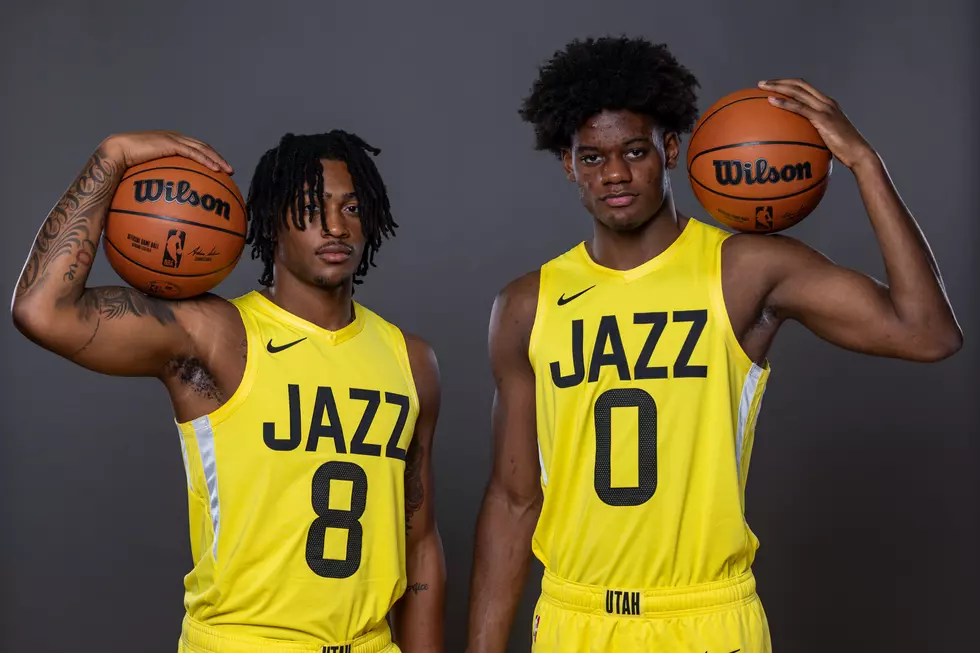
Free! National Parks Offer Free Admission These Six Days A Year
We live so close to so many beautiful places -- Zion National Park is 40 minutes away, Grand Canyon North Rim is just a couple hours drive, as is Bryce Canyon. Capitol Reef is just a three-hour drive, while Canyonlands and Arches are less than five hours by car.
With this much enchanting scenery being so close, it's worth noting that entrance to these wonders does cost money. Generally speaking, it's about $35 to drive into one of these parks, although a yearly pass to ALL National Parks is just $80.
There are also free or discounted passes available for senior citizens, current members of the military, families of fourth-grade students, and disabled citizens. Click here to learn more about the variety of passes offered by the America the Beautiful National Parks and Federal Recreational Lands Pass series.
But did you know there are six days a year when you can get into these National Parks absolutely free?
Those days are:
- January 15: Birthday of Martin Luther King, Jr.
- April 20: First day of National Park Week
- June 19: Juneteenth National Independence Day
- August 4: Anniversary of the Great American Outdoors Act
- September 28: National Public Lands Day
- November 11: Veterans Day
It's worth noting that there are actually 400 National Parks in the United States. Of the 400, 292 offer free entrance every day of the year.
The BIg 108, parks like Zion, Bryce and Grand Canyon, use the entrance fees to pay staff, maintain trails, clean and maintain bathrooms and keep roads passable and serviced.
At Zion National Park, shuttle service and other visitor services are also supported with entrance fees.
Recently, a group of three people filed a lawsuit against the National Park Service as it had recently announced all parks were going cashless -- accepting only credit and debit cards.
According to the NPS, "Reducing cash collections allows the National Park Service to be better stewards of the fees collected from visitors. Cashless options reduce transaction times at busy entrance stations and decrease the risk of theft. Moving to a cashless system improves accountability and consistency, reduces chances of errors, and maximizes the funding available for critical projects and visitor services."
The NPS also added that, "Most parks that have converted to cashless fee collection have had an overwhelmingly positive experience."

In Southern Utah, These Pests Are Living Rent Free And You're The Landlord
If you've lived in Southern Utah for very long, there's a high probability you've seen scorpions, rattlesnakes and black widow spiders.
These pests, and a few others, are living rent free in your homes and yards -- and you're the landlord.
Here's a list of the Top 7 houseguests, er, house-pests in Southern Utah:
- Cockroaches -- The roaches we have here are most closely related to the common Arizona cockroach. They are not particularly big, but are hearty, fast and die hard. They love your kitchen, basement and bathroom.
- Rodents -- Mice or rats are not as common here as the heat tends to cull the population, but make no mistake, they are here. They will chew through wires, walls and baseboards. And they carry diseases. They love your storage rooms and pantries.
- Lizards -- Most people feel they're innocuous and even helpful as they eat bugs. Others call them "reptile rats." Either way, they sleep all winter and emerge everywhere when it warms up. They love your yards and rock art.
- Scorpions -- According to Utah State's wildlife website, "There are several scorpion species that live within the state of Utah, specifically the Arizona Bark Scorpion, Giant Desert Hairy Scorpion, Black Hairy Scorpion, and Northern Scorpion. USU adds "Some scorpions are more venomous than others, but all are more afraid of you than you should be of them." They can be painful, but rarely deadly. They love your desert foliage.
- Black widow spiders (Lactrodectus hesperus) are the most dangerous spiders to humans in Utah. Bites may be fatal to young children or older adults. Fortunately, widow spiders are fairly sedentary and spend majority of the time in their webs. They love dark and cool places like crawl spaces and basements.
- Ants -- The biting "fire ants" are rare in Utah, but we have plenty of other ant types. The most common in So. Utah is the Carpenter Ant. While their bites are harmless, they do carry diseases and infest food supplies. They love kitchens and "crumby" TV rooms.
- Wasps/hornets -- They work in colonies (social insects), they'll build a hive and fight you if you try to destroy it. Their stings are painful, but only dangerous when allergic. They like your porches, eaves and corners of your houses.
There are more, but these are the most prevalent.
So when your college kids comes to visit, tell them you already have houseguests.
Multiple websites recommend calling a professional exterminator if you have a problem with any of these "houseguests."

So. Utah's Entrepreneurial Spirit Shines: Top Small Business Cities Are Here
Washington City, St. George and Cedar City were named the top three small cities in America for starting a small business by WalletHub.com, in a study released last year..
Big deal, right? Top three cities in Southern Utah? Well, no. The top three small cities in Utah then? Uh, no. The top three small cities in the West. Um, nope.
See, the list took a look at the 1,334 small cities (25,000-100,000 population) in the entire United States, entered a complex 13-point algebraic equation that took into account business environment, access to resources and the cost of running a business, and came up with unbiased winners.
And Washington City won for the second year in a row. The 2024 list is due out next month, but there's no reason to believe Washington City won't do well once again.
“We could not be more excited to be ranked the No. 1 small city to start a business for the second year in a row," said Washington City mayor Kress Staheli. "The secret is out; Washington City is open for business. That entrepreneurial spirit is in our blood. Our pioneer ancestors were hard-working, resilient, and innovative.”
The study found out what we already knew -- Southern Utah is a progressive, hard-working region that executes the American Dream to a tee.
Along with Washington City, St. George (which barely qualified population-wise at 99,000) was second and Cedar City was third.
In fact, not surprisingly Utah did well and certain regions to our West (um, rhymes with Malifornia) were among the worst.
All totaled, Utah had six of the top 11 small business friendly towns on the list with Logan fifth, Lehi ninth and Eagle Mountain 11th, and the Beehive state had 18 of the top 100 towns listed. Florida also did well with 39 of the top 100 towns from the Sunshine State (although only two Florida cities made the top 10, South Bradenton at six and Fort Myers at eight).
The bottom of the list saw three California cities (Oakley ranked as No. 1,331, Saratoga at 1,333 and Cupertino at 1,334) and two Maryland burgs (Olney at 1,330 and Potomac at 1,332) bring up the rear.
Here are the qualifications used and point values:
Business Environment – Total Points: 50
- Average Length of Work Week (in Hours): Full Weight (~5.56 Points)
- Average Commute Time: Full Weight (~5.56 Points)
- Average Growth in Number of Small Businesses: Double Weight (~11.11 Points)
- Startups per Capita: Double Weight (~11.11 Points)
- Average Revenue per Business: Full Weight (~5.56 Points)
- Average Growth of Business Revenues: Full Weight (~5.56 Points)
- Industry Variety: Full Weight (~5.56 Points)
Access to Resources – Total Points: 25
- Financing Accessibility: Double Weight (~5.56 Points)
Note: This metric was calculated as follows: Total Annual Value of Small-Business Loans / Total Number of Small Businesses. - Investor Access: Double Weight (~5.56 Points)
- Human-Resource Availability: Full Weight (~2.78 Points)
Note: This metric was calculated by subtracting the “unemployment rate” from the “number of job openings per number of people in labor force.” - Higher-Education Assets: Full Weight (~2.78 Points)
Note: This metric is based on WalletHub’s “College & University Rankings.” - Workforce Educational Attainment: Full Weight (~2.78 Points)
Note: This metric measures the percentage of the population aged 25 and older with at least a bachelor’s degree. - Working-Age Population Growth: Full Weight (~2.78 Points)
Note: “Working-Age Population” includes those aged 16 to 64. - Job Growth (2021 vs. 2017): Full Weight (~2.78 Points)
Business Costs – Total Points: 25
- Office-Space Affordability: Full Weight (~6.25 Points)
Note: This metric measures the per-square-foot cost of commercial office space. - Labor Costs: Full Weight (~6.25 Points)
Note: This metric measures the median annual income. - Corporate Taxes: Full Weight (~6.25 Points)
Note: Data for this metric were available only at the state level. - Cost of Living: Full Weight (~6.25 Points)
The full list is here: Best Small Cities For Starting a Business.

Ice Ice baby! Utah's Love Affair With Pebble Ice
I love ice!
It's so versatile.
Sore muscles? Ice them. Warm drink? Ice it. Thirsty? Suck on some ice.
Even doctors will let you chew on ice chips or pebbles when you're not allowed to eat anything else (if you've ever stayed in the hospital, you know what I'm talking about).
I especially love ice to cool down my favorite beverage -- Dr. Pepper. In fact, I've gotten so bad, I don't even like to drink Dr. Pepper "straight" (without ice). It is a little strong that way.
But my older sister, Laura, who lives in Southern Utah as well, is the biggest ice lover I know.
When she goes to restaurants, she order extra ice every time. To her, a drink is not prefect until there are ice chips or cubes from the bottom of the cup to the rim.
A true ice lover.
However, in Europe, ice is not popular.
Some of that makes sense. They drink lots of wine and beer (or ale) in Europe, two beverages that don't require ice.
In fact, I remember an old sitcom episode in which the girl, a non-beer drinker, serves her new boyfriend a glass of beer with a handful of ice cubes.
It got a big laugh.
But why don't Europeans like ice, even in their soda pop?
Apparently, the only way Europeans got ice back in the 1800s was to have it shipped across the sea from Canada or other cold areas of North America.
Because of this, ice was very expensive. Reader's Digest picks it up from here:
"Putting ice in your drink started to become somewhat of a fashion trend for the wealthy in Britain. Some would put a few cubes in their champagne and sip on their chilled drinks at high-class parties. But, like with any fashion trend, it eventually faded, mainly because the ice was just too expensive. And even once ice boxes began appearing in homes in Britain as well, Brits never took a liking to ice in their drinks."
That explains a lot. They just never got in the habit of putting ice in their drinks.
In Utah, we really love ice in our drinks. Of course a large percentage of us don't drink beer or wine, which helps explain this phenomenon a lot.
A new trend is starting to become prevalent. A lot of folks like to eat ice, especially if they can find it in pebble form.
Medical News Today, a website touting healthy lifestyles, said chewing ice is mostly harmless, although it could be a sign of something more serious:
"Sucking on or chewing ice in moderation is unlikely to cause harm. However, anyone who feels a compulsion to eat ice may require medical attention. If ice cravings last for longer than 1 month, a doctor should investigate the underlying cause."
Anemia could be the cause.
The commercial website freezimer.com, gives nine reasons we love the stuff:
1. The Best Ice to Chew
There are some people who just love to chew on ice. These people are going to absolutely love nugget ice. The nugget ice offers you the cold and refreshing feeling that you love from chewing on ice, but with a softer and more satisfying chewing feeling. So, if you like to eat the ice after your beverage is gone, you might have the most satisfying experience with nugget ice.
2. Cools Quickly
The way that nugget ice is created and the shape that is has gives it a quality of rapid cooling. No matter what you are using nugget ice with, it will get cooled quicker. You can get a cooler feeling when you put nugget ice on an injury or quickly cools off your beverage. For example, the nugget ice has a contoured shape to it which allows the ice to better conform when you put it on an injury.
3. Better Retain the Drink’s Flavor
A lot of people enjoy eating their ice after they finish a beverage. However, you normally can’t taste much of the drink that was formerly in the glass when you do. For some unknown reason, nugget ice is able to retain the flavor of the beverage long after you’ve finished it. This can help you better enjoy the ice after your drink is gone.
4. Best Ice for Frozen Drinks
Frozen drinks require the right ice to make them next level drinks. Nugget ice is the superior ice when making smoothies and other frozen drinks. Once reason why is because the machines used to make nugget ice can typically make ice a lot faster than other ice makers. This makes it not only good for making frozen drinks but also for making frozen drinks for a crowd. The nature of this ice is that it’s softer, which makes it less likely to damage the blades of your blender when making frozen drinks. Lastly, you can easily and quickly make these drinks since the ice can break down easier.
5. Great for Salad Bars
Remember how we said that nugget ice has this incredible ability to cool things quickly? It’s also the ideal option for things like cooling salad bars. Using nugget ice to keep salads, vegetables, fruits, and even containers of soda can be the most effective way to keep these items at a great temperature.
6. Doesn’t Melt Quickly
A major downside with crushed ice is that it can tend to melt very easily. The good thing about nugget ice is that it doesn’t melt nearly as quickly as crushed ice does. This means that not only will your drinks stay cooler longer, but you also don’t have to worry about your drinks getting watered-down as quickly. Keep your drinks cold and full flavored by using nugget ice instead of options like pellet ice or pebble ice.
7. Fits Nicely in Any Glass
Sometimes ice doesn’t fit as well as you want it to in your glass. For instance, the cubed or ball of ice looks great but isn’t the most practical ice to use. Nugget ice is smaller and can cool drinks more efficiently. Their unique shape allows them to fit in any container, no matter the shape, so that you can enjoy a nice, chilled beverage in any container.
8. Easy on the Teeth
Ice can be pretty rough on the teeth. Chewing on the ice can tend to hurt your teeth, making it an unpleasant experience. The reason why nugget ice is easy on the teeth is because it is light and airy. This has a soft texture that is very easy on the teeth.
9. Better for Restaurants
Restaurants will love using pebble or nugget ice when serving drinks. This is because you can use more surface area with this type of ice, meaning that you can get away with using less actual drink in the glasses. Since the ice melts slower than other types of ice, the customers won’t notice this and will better enjoy their beverages.
Another theory, from mashed.com is this:
"What exactly is it that makes pellet ice so renowned? It's hard to imagine how ice became the obsession of so many foodies and cocktail connoisseurs — that is, until you've tried it. Pellet ice may not sound like much to the inexperienced palette, but as many Sonic devotees know (the fast-food chain was one of the first locations to serve pellet ice in their drinks, per Food52), it's hard to return to the hard uniformity of ice cubes past once you've tried it."

Unlocking Peace Of Mind: The Significance Of Advance Directives In Utah
No one likes to think about it, but what is your plan for your last days?
Are you donating your organs? Should extreme measures be taken to save you? Do you want a machine to keep you alive? How long is too long to be in a coma?
These are unpleasant, but real questions that may arise as we age.
One of the lessons learned from the COVID-19 pandemic is that people may be faced with a serious illness or a medical emergency that required vital decisions about their medical care, and sometimes those decisions couldn’t be made by the patient themselves. This has brought awareness to the need for making an advance directive.
National Healthcare Decisions Day, is an initiative held annually on April 16, to encourage people to make an advance directive and to discuss their wishes about future healthcare decisions and put them in writing before a health crisis occurs. This helps loved ones, providers and facilities be aware of and respect those wishes. People can also specify what life-sustaining treatments they do or do not wish to have.
To honor this national initiative, eight different Utah health organizations have come together to bring awareness to the need for people to make an advance directive. The organizations include: Comagine Health, Intermountain Health, MountainStar Healthcare, Steward Health Care, University of Utah Health, the Utah Hospital Association, the Utah Geriatric Education Consortium, and the Utah Nurses Association.
“Designating a trusted healthcare representative who is aware of your wishes is the most important part of an advanced directive. Doing this means you’ll have an advocate who can speak on your behalf about medical decisions when you’re unable to,” said Dominic Moore, MD, a pediatric palliative care physician, with University of Utah Health and senior medical director of palliative care at Intermountain Health. “When a person’s wishes are unknown, these tough situations can be filled with uncertainty or guilt.”
Physicians who care for seriously ill patients say advance directives are important for anyone over age 18 and even younger, if they have a serious chronic condition. They agree these are difficult, but very important conversations to have.
“Filling out an advance directive form and sharing it makes it official. But, it’s also very important to have a conversation with your healthcare representative and other loved ones, so they all know who has been designated to make medical decisions for you, when you cannot make them for yourself. These conversations will also help others understand your values and what quality of life is important to you,” said Filip Roos, MD, chief medical officer, MountainStar Healthcare.
During these conversations, palliative care physicians encourage people to share what makes them feel like they’re living life, and not just existing. Advance directives help paint a picture, so others can make decisions about questions that are hard to predict in advance. It’s difficult to anticipate all the medical scenarios.
“Having a signed advance directive is particularly important for those living in rural areas, where access to care often requires leaving your home community for treatment in a distant, urban setting. Having official documentation during those difficult transitions helps ensure healthcare representatives are included in conversations and your wishes are honored,” said Linda S. Edelman RN, PhD, director, Utah Geriatric Education Consortium.
Health providers say it’s a good idea to update advance directives annually, or if one of the “four D’s” occurs:
- Diagnosis – receiving a serious diagnosis
- Decline – in health
- Divorce – typically impacts who is designated to make medical decisions on behalf of a spouse
- Death – of the designated healthcare representative
They recommend people keep all their information up to date and check the legal requirements for paperwork in the state where they live. Advance directive forms can be completed online, on paper, at home or in a doctor’s office or a hospital.
For more information visit National Healthcare Decisions Day for state-specific requirements. Advance directive forms for Utah can be found here.
LOOK: The biggest scams today and how you can protect yourself from them
Beware of These 50 Jobs That Might Vanish in the Next 50 Years
More From Sports Radio 97.7








